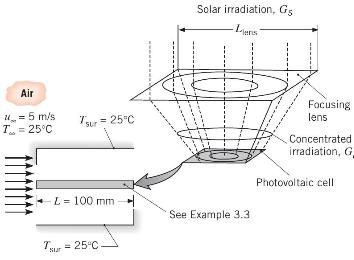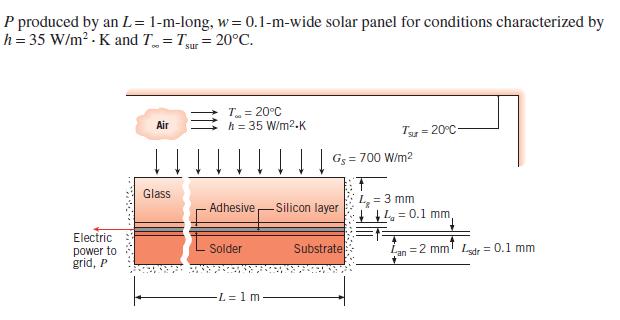Consider the concentrating photovoltaic apparatus of Problem 7.15. The apparatus is to be installed in a desert
Question:
Consider the concentrating photovoltaic apparatus of Problem 7.15. The apparatus is to be installed in a desert environment, so the space between the concentrating lens and top of the photovoltaic cell is enclosed to protect the cell from sand abrasion in windy conditions. Since convection cooling from the top of the cell is reduced by the enclosure, an engineer proposes to cool the photovoltaic cell by attaching an aluminum heat sink to its bottom surface. The heat sink dimensions and material are the same as those of Problem 7.22. A contact resistance of \(0.5 \times 10^{-4} \mathrm{~m}^{2} \cdot \mathrm{K} / \mathrm{W}\) exists at the photovoltaic cell/heat sink interface and a dielectric liquid \(\left(k=0.064 \mathrm{~W} / \mathrm{m} \cdot \mathrm{K}, ho=1400 \mathrm{~kg} / \mathrm{m}^{3}, c_{p}=1300 \mathrm{~J} / \mathrm{kg} \cdot \mathrm{K}\right.\), \(v=10^{-6} \mathrm{~m}^{2} / \mathrm{s}, \operatorname{Pr}=25\) ) flows between the heat sink fins at \(u_{\infty}=3 \mathrm{~m} / \mathrm{s}, T_{\infty}=25^{\circ} \mathrm{C}\).
(a) Determine the electric power produced by the photovoltaic cell and the silicon temperature for a square concentrating lens with \(L_{\text {lens }}=400 \mathrm{~mm}\).
(b) Compare the electric power produced by the photovoltaic cell with the heat sink in place and with the bottom surface cooled directly by the dielectric fluid (i.e., no heat sink) for \(L_{\text {lens }}=1.5 \mathrm{~m}\).
(c) Determine the electric power output and the silicon temperature over the range \(100 \mathrm{~mm} \leq L_{\text {ens }}
Data From Problem 7.15:-
Concentration of sunlight onto photovoltaic cells is desired since the concentrating mirrors and lenses are less expensive than the photovoltaic material. Consider the solar photovoltaic cell of Example 3.3. A \(100 \mathrm{~mm} \times\) \(100 \mathrm{~mm}\) photovoltaic cell is irradiated with concentrated solar energy. Since the concentrating lens is glass, it absorbs \(10 \%\) of the irradiation instead of the top surface of the solar cell, as in Example 3.3. The remaining irradiation is reflected from the system (7\%) or is absorbed in the silicon semiconductor material of the photovoltaic cell (83\%). The photovoltaic cell is cooled by air directed parallel to its top and bottom surfaces. The air temperature and velocity are \(25^{\circ} \mathrm{C}\) and \(5 \mathrm{~m} / \mathrm{s}\), respectively, and the bottom surface is coated with a high-emissivity paint, \(\varepsilon_{b}=0.95\).

(a) Determine the electric power produced by the photovoltaic cell and the silicon temperature for a square concentrating lens with \(L_{\text {lens }}=400 \mathrm{~mm}\), which focuses the irradiation falling on the lens to the smaller area of the photovoltaic cell. Assume the concentrating lens temperature is \(25^{\circ} \mathrm{C}\) and does not interfere with boundary layer development over the photovoltaic cell's top surface. The top and bottom boundary layers are both tripped to turbulent conditions at the leading edge of the photovoltaic material.
(b) Determine the electric power output of the photovoltaic cell and the silicon temperature over the range \(100 \mathrm{~mm} \leq L_{\text {lens }} \leq 600 \mathrm{~mm}\).
Data From Example 3.3:-


Step by Step Answer:

Fundamentals Of Heat And Mass Transfer
ISBN: 9781119220442
8th Edition
Authors: Theodore L. Bergman, Adrienne S. Lavine





